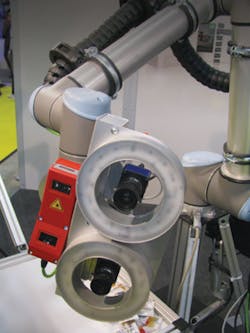Robots and Vision: Robotic vision system checks car fenders
To ensure the integrity of car fenders, automobile manufacturers are employing vision-equipped robotic systems. When deployed on the production line, these systems are used to check whether the proper grille has been attached, whether all the fasteners are properly attached and to check for the correct placement of collision and park placement sensors. To validate the correct placement of such components for the Mercedes C Series, the VW Passat and Audi A3 and TT series, Attentra (Tübingen, Germany; www.attentra.de) has developed a robotic vision system that employs both 3D and visible spectrum cameras.
Shown at the VISION Show, held in Stuttgart in November last year, the system consists of a six axis UR10 robot from Universal Robotics (Odense, Denmark; www.universal-robots.com) which is fitted with an LPS 36 line profile sensor from Leuze Electronic (Owen, Germany; www.leuze.com) and two mvCougar-X GigE cameras from Matrix Vision (Oppenweiler, Germany; www.matrix-vision.com).
"Before any vision-based validation of the fender's component parts can be validated," explains Christian Vollrath, President of Attentra, "the robot head must be positioned correctly." To achieve this, an operator first uses the teach pendant of the robot to position the imaging system at specific points to capture individual images.
In modern crash detection systems, such as the type used in the Mercedes C class, for example, an air-filled tube is attached across the length of the fender. Should a collision occur, a pressure change in the tube will trigger pressure sensors to actuate airbags in the vehicle. To ensure that this tube is correctly fitted in its plastic housing, the system is first trained to capture a series of images of the tube using the LPS 36 line profile sensor as the robot head moves across the tube. By projecting a laser line scan across the tube and capturing the resultant reflected images, laser triangulation can then be used to generate a depth profile of the tube.
In the Attentra system, HALCON from MVTec Software (Munich, Germany; www.mvtec.com) is then used to make three-dimensional measurements of the tube. The position of this tube relative to its housing can then be used to determine whether the part is correctly positioned.
To determine whether specific components such as the pressure sensor, park placement sensors and fasteners are properly attached, the Attentra system captures images from the two mvCougar-X cameras and transfers them over a GigE interface to a host PC.
To illuminate the parts as these images are captured, the cameras are fitted with two red LED ring-lights from Büchner Lichtsysteme (Welden, Germany; www.buechner-lichtsysteme.de). According to Vollrath, these provide a homogenous light source for industrial environments such as automobile assembly plants where lighting conditions are not easily controlled.
While one camera is configured to image small field of views of the car fender, the second camera allows larger areas to be imaged. This is especially useful since the system can be more easily deployed to accommodate a variety of car fenders from multiple manufacturers. Images captured from these cameras are again analyzed by MVTec's Halcon software that is used to validate the correct fitting of all the collision and park placement sensors and whether the correct parts have been placed.
To allow the operator to visualize whether all the components' parts have been correctly fitted, Attentra has developed a graphical user interface in C++. This allows the operator to visualize the complete fender and highlights the component parts that may be missing or badly fit. "Since each manufacturer's fenders may vary dramatically," says Vollrath, "the system must be programmed to take account of each individual part. Thus, the end-user cost of such a system will depend on the number of inspection tasks to be performed since each task will require custom programming."

